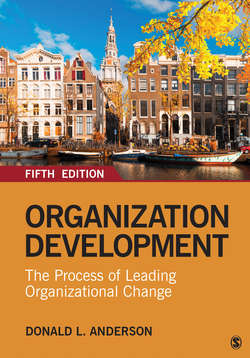Читать книгу Organization Development - Donald L. Anderson - Страница 12
На сайте Литреса книга снята с продажи.
Making the Case for Organization Development
ОглавлениеPerhaps the point on which most definitions agree is that the backdrop and purpose of organization development is change. As you have no doubt personally experienced, large-scale organizational change is rarely simple and met without skepticism. As Peter Senge and colleagues (1999) write, “Most of us know firsthand that change programs fail. We’ve seen enough ‘flavor of the month’ programs ‘rolled out’ from top management to last a lifetime” (p. 6). Because of its impact on the organizational culture and potential importance to the organization’s success, organizational change has been a frequent topic of interest to both academic and popular management thinkers. With change as the overriding context for OD work, OD practitioners develop interventions so that change can be developed and integrated into the organization’s functioning. Significant changes today are facing organizations and their teams and individual employees.
To become effective, productive, and satisfying to members, organizations need to change. It will come as no surprise to any observer of today’s organizations that change is a significant part of organizational life. Change is required at the organizational level as customers demand more, technologies are developed with a rapidly changing life cycle (especially high-tech products; Wilhelm, Damodaran, & Li, 2003), and investors demand results. As Rita McGrath (2013) writes, “Music, high technology, travel, communication, consumer electronics, the automobile business, and even education are facing situations in which advantages are copied quickly, technology changes, or customers seek other alternatives and things move on” (p. 7). This requires that organizations develop new strategies, economic structures, technologies, organizational structures, and processes.
Change is required of team members, who now are likely to work virtually in collaboration with members from around the globe. Cultural differences, changes in communication technologies, and a changing diverse workforce all combine to complicate how team members work together. Role conflict and confusion in decision processes and decision authority are common when members who have never worked together are thrown into an ad hoc team that is responsible for rapid change and innovation.
Change is also required of individuals. Employees learn new skills as jobs change or are eliminated. Organizational members are expected to quickly and flexibly adapt to the newest direction. Best-selling business books such as Who Moved My Cheese? teach lessons in ensuring that one’s skills are current and that being comfortable and reluctant to adapt is a fatal flaw. Leaders today need to adapt to matrix organizational structures and new participative styles of leadership rather than old hierarchical patterns and command and control leadership (Holbeche, 2015). For organizational members, change can be enlightening and exciting, and it can be hurtful, stressful, and frustrating.
Whether or not we agree with the values behind “change as a constant,” it is likely to continue for the foreseeable future. Whereas some decry an overabundance of change in organizations (Zorn, Christensen, & Cheney, 1999), others note that it is the defining characteristic of the current era in organizations and that becoming competent at organizational change is a necessary and distinguishing characteristic of successful organizations (Lawler & Worley, 2006).
There are, however, more and less effective ways to manage change. Creating and managing change in order to create higher-performing organizations in which individuals can grow and develop is a central theme of the field of OD. When we speak of organization development, we are referring to the management of certain kinds of these changes, especially how people implement and are affected by them.
